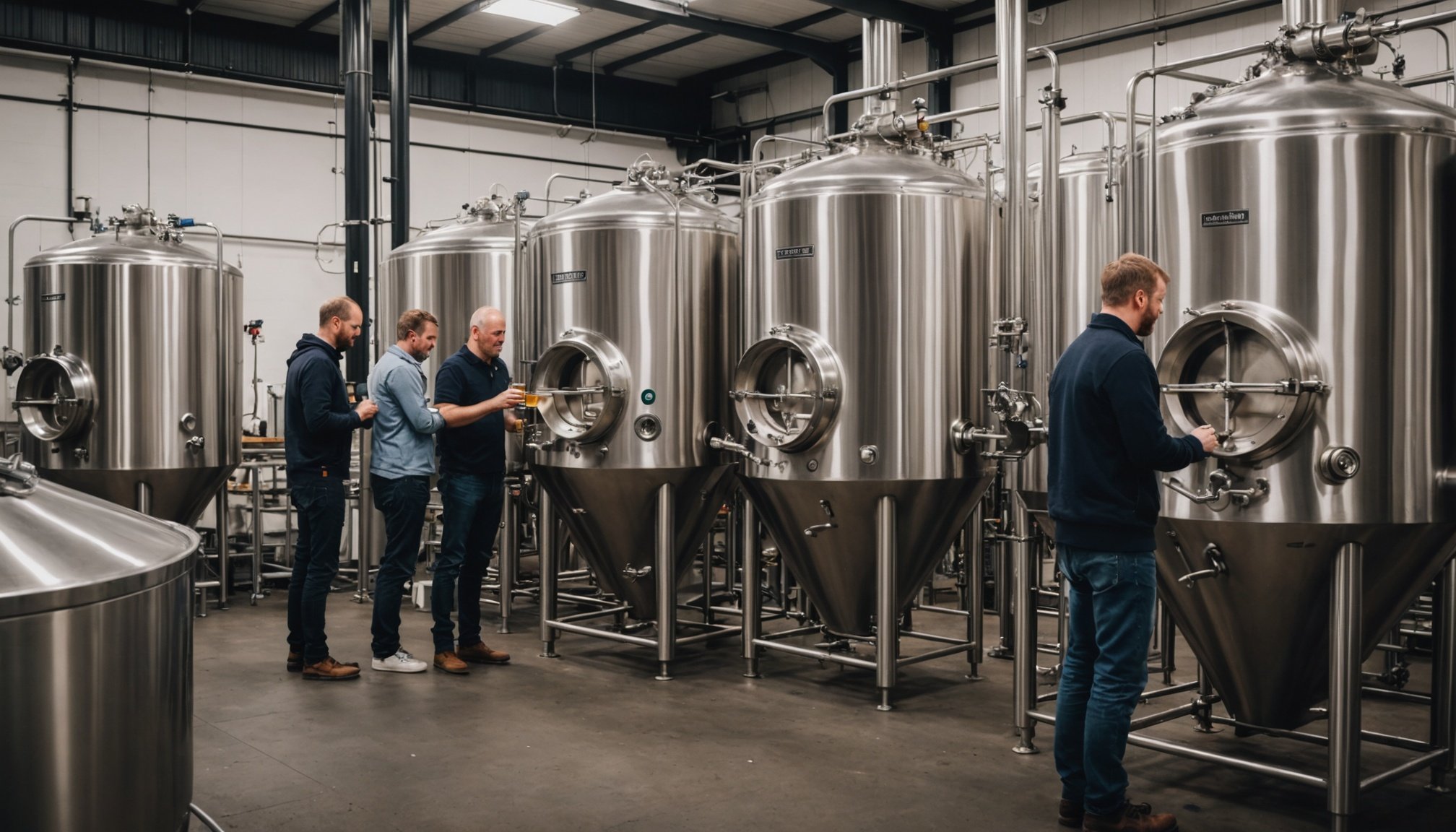Overview of the Non-Alcoholic Beer Market in the UK
The non-alcoholic beer market in the UK is experiencing significant growth, driven by changing consumer lifestyles and preferences. This shift is reflected in the rising popularity of UK beer trends focusing on health-conscious choices. Market analysis indicates that consumer demand for non-alcoholic beer is expected to continue its upward trajectory, projecting robust growth in the coming years.
The UK demographic showing particular interest in non-alcoholic beers includes younger consumers and those seeking healthier lifestyles. This trend is not only reshaping the traditional beer market but also attracting new consumers who prioritise wellness over high-alcohol content.
Also read : Essential Tactics for UK Healthcare Providers to Seamlessly Embrace AI Diagnostics
The competitive landscape features numerous established breweries expanding their non-alcoholic offerings, alongside new entrants eager to capture market share. Brands are increasingly focusing on quality and diversity to stand out, with some embracing innovative brewing techniques to enhance flavour and appeal.
In summary, this dynamic market is ripe with opportunities for growth. By leveraging emerging UK beer trends and understanding consumer demands, brands can effectively compete within this evolving segment. Whether driven by health trends or market analysis, the non-alcoholic beer market is poised for continued expansion.
Also to see : Essential Cybersecurity Tactics Every UK Business Must Implement for Maximum Protection
Successful Case Studies of UK Breweries
In the rapidly expanding non-alcoholic beer market, certain UK breweries have carved out significant successes. An examination of these successful breweries provides insightful case studies into the strategies that have catalysed their achievements.
Case Study: Brewery A
Brewery A stands out for implementing a blend of traditional techniques with modern innovation. Its strategic focus on maintaining beer authenticity, while appealing to health-conscious consumers, has proven effective. The brewery’s approach has resulted in a notable increase in both customer base and market share.
Case Study: Brewery B
Brewery B embraced innovative approaches, particularly in consumer engagement. By launching limited-edition flavours via online exclusive sales and engaging directly with consumers through digital platforms, Brewery B has fostered a loyal customer community. This strategy has strengthened brand loyalty and heightened brand visibility.
Case Study: Brewery C
Marketing tactics at Brewery C have been pivotal, with a strong focus on branding and storytelling. Through crafting a compelling narrative around their products and leveraging large-scale events, Brewery C has succeeded in expanding its reach. The company has experienced substantial revenue growth and increased its market share significantly.
These case studies underscore the effectiveness of strategic innovation and personalised consumer engagement in thriving within the UK’s non-alcoholic beer sector.
Consumer Preferences and Trends
In the evolving non-alcoholic beer market, consumers are increasingly gravitating towards healthier beverage options. With growing awareness around health and wellness, there’s a noticeable shift among consumers opting for beverages that support a balanced lifestyle. These trends are particularly dominant among younger demographics who prioritize nutritional content.
When it comes to flavour preferences, consumers are showing openness to experimentation, seeking unique flavour profiles in their non-alcoholic beers. Fruity and citrusy notes are increasingly popular, mirroring broader trends within the UK beer markets. Brands focusing on these tastes stand to gain a competitive edge.
The significance of branding and presentation in consumer choice cannot be overstated. Eye-catching packaging and strong brand narratives are paramount in attracting consumers. It’s crucial for brands to craft compelling stories around their products that resonate with the health-conscious market segment.
Market research indicates that brands successful in aligning their offerings with consumer preferences are more likely to thrive. As the demand for innovative and healthier non-alcoholic beers grows, staying attuned to consumer trends will be key to sustained growth. Embracing these dynamics provides a clear path for brands to enhance their market presence.
Innovative Product Development Strategies
In the expanding non-alcoholic beer market, breweries are tapping into the power of innovation to satisfy health-conscious consumers. Experimentation with unique flavour profiles plays a crucial role. Classic beer notes are blended with exotic ingredients, resulting in exciting combinations like ginger and lemongrass or blueberry and basil. This creativity enhances appeal and captures adventurous palates.
Flavor Experimentation Techniques
Brewing innovation drives the quest for diverse flavours. Techniques such as dry-hopping or barrel-aging introduce distinguishing taste nuances. Some breweries use yeast strains that minimize alcohol production but retain flavour integrity, ensuring a satisfying experience without the alcohol content.
Leveraging Technology in Brewing
Advanced technology is reshaping how non-alcoholic beers are crafted. Reverse osmosis and vacuum distillation are examples of brewing innovation that extract alcohol while preserving flavour-rich compounds. The implementation of AI in recipe formulation further ensures precision and consistency, maintaining brewer’s intent across batches.
Collaborations with Local Producers and Influencers
Partnerships with local farmers, artisans, and influencers are advantageous for product development. Breweries often source local ingredients, which enriches the product development narrative and appeals to regional consumer loyalty. Collaborations with influencers amplify market reach, showcasing new brews to larger, engaged audiences.
Marketing Strategies for Non-Alcoholic Beers
Navigating the non-alcoholic beer market requires astute marketing strategies to attract and retain consumers effectively. Social media campaigns have become indispensable, allowing brands to reach health-conscious audiences. Platforms like Instagram and Facebook offer opportunities for creative engagement, using vibrant visuals and storytelling that highlight the benefits and flavours of non-alcoholic options.
Emphasizing the narrative around non-alcoholic beers plays a pivotal role in consumer marketing. Storytelling can transform a simple product into a lifestyle choice that resonates well with the audience, cultivating a sense of identity and purpose around the brand. Sharing behind-the-scenes content or customer stories can strengthen this connection.
Leveraging live events and tastings offers another layer of brand promotion. These gatherings allow consumers to experience new products firsthand and create personal associations with the brand. Such events can be enhanced with interactive elements or collaborations with influencers, broadening reach while fostering community interest.
Effective marketing strategies help brands establish themselves in the UK beer trends landscape and boost consumer loyalty. By adapting techniques that align with contemporary consumer behaviours, breweries can carve a distinct place in the burgeoning non-alcoholic beer sector.
Regulatory Considerations in the Non-Alcoholic Beer Market
The non-alcoholic beer market in the UK is subject to particular regulations that breweries must diligently adhere to. Beer industry laws are crucial in maintaining production standards and ensuring consumer safety. Non-alcoholic beers, being distinct from traditional counterparts due to their lower alcohol content, are defined by specific parameters. In the UK, to be classified as non-alcoholic, beers must generally contain less than 0.5% ABV.
Compliance challenges frequently arise in adjusting traditional brewing methods to meet these legal standards. Breweries must carefully monitor the fermentation process to ensure adherence to these thresholds, which can involve significant technological investment and quality control measures. Moreover, understanding and navigating labeling and advertising guidelines is crucial. Labels must accurately convey alcohol content and make no misleading claims about health benefits.
Advertising must align with regulatory frameworks that prohibit promoting them as fully alcohol-free experiences. Missteps can lead to legal penalties and damage to brand reputation. Therefore, staying informed about evolving regulations and industry laws is essential for breweries to maintain compliance and market position, as they expand within the non-alcoholic sector.
Future Trends and Opportunities
As the non-alcoholic beer market continues to evolve, several future trends and market opportunities are emerging. The increasing awareness of health benefits associated with non-alcoholic beverages is expected to drive consumer preferences significantly. Consumers are shifting towards options that complement their healthy lifestyle, leading to an increased interest in low-calorie and organic non-alcoholic beer varieties.
Emerging technologies, such as AI in brewing and enhanced fermentation techniques, hold substantial innovation potential. These advancements promise greater precision and efficiency in producing flavoursome non-alcoholic beers while meeting legal requirements. As technology continues to evolve, brewers can create innovative recipes that keep pace with these trends.
Furthermore, market opportunities are ripe for new entrants who can offer unique value propositions. Differentiation through innovative flavours or sustainable production processes could captivate consumers and capture market share. The integration of local ingredients into brewing processes and eco-friendly initiatives are likely to resonate well with environmentally conscious consumers.
In conclusion, those willing to capitalise on these future trends and leverage innovation potential will likely find success in expanding their presence in the flourishing non-alcoholic beer market.





